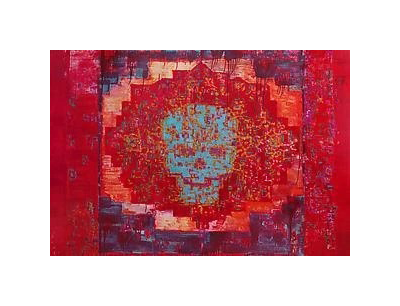London
29 October 2013 - 3 December 2013
Following its much-touted launch in September 2013, Taymour Grahne Gallery presents new works by Iranian painter, musician and performance artist Reza Derakshani. Expanding on previous investigations of ornamentation and abstraction, “My Wicked Persian Carpet” incorporates the artist’s newfound experimentation with materials such as glitter to consider ongoing themes of life and death, faith and fear, love and revulsion, beauty and viciousness, light and darkness. Flat colorfields and a lack of perspective, always a signature component of Derakshani’s compositions, meld tradition and political references into highly textured, jewel-like paintings. The series derives its raw strength from an uncomfortable contrast—deceptively beautiful, almost hedonistic decorative qualities cut with bleak, apocalyptic manifestations of death—a result that is hypnotically and universally unsettling.
Born in the rustic countryside of Sangsar, Iran, Derakshani’s detailed observation of the natural world is apparent in his work, as is his inspiration from Persian art and folkloric traditions; the imagery of gardens, epics, and miniatures is a critical part of his visual narrative. After leaving Iran in the aftermath of the revolution, Derakshani incorporated influences of Western modernist painting and Persian motifs to develop a visual language of his own, which richly and often piercingly addresses the challenges of calling multiple places home, and the complexity and trauma of modern Iranian cultural history.
This latest series was motivated by Derakshani’s return to his native country, where, disappointed by what he saw after decades living overseas, a commentary on the state of Iran today has manifested itself in “My Wicked Persian Carpet.” However, as Scott Indrisek writes in his essay accompanying the exhibition catalog: “Defining Derakshani as a political painter would be reductive—shrinking his oeuvre into little more than an extended, anguished salvo against a regime—and it’s more interesting to note the unavoidable ways that such concrete realities are instead ingested, and transformed, by the artist.”
